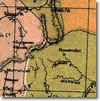
Welfare Body entry
| Home | Browse | Search | Previous | Next |

|
Unlocking Regional Memory
Welfare Body entry
|
|
Armidale Association for the Assimilation Aborigines (1956 - 1974) |
|
|
|
| Location: Armidale, New South Wales, Australia | |
Formerly known as the Association for the Assimilation of Aborigines, the organisation began in Armidale in 1956. The organisation, established by wives of academic staff at the University of New England, was involved in raising funds for the welfare of local Aborigines. Concentrating on better clothing, food and housing. |
Details |
|
The Association for the Assimilation of Aborigines was formed in Armidale in 1956 after some wives of academic staff at the University of New England suggested that the newly-formed Women’s Association should become involved in the welfare of local Aborigines. According to Edna McIntosh, one of the Association’s founders, the University was reluctant to become involved with the scheme for fear that local graziers ‘who had given thousands of pounds to the University would be worried about time spent on Aboriginal welfare’. The ensuing debate within the Women’s Association was so acrimonious that it was never recorded in the official minutes. In the aftermath, McIntosh and other interested members of the Women’s Association decided to form a separate organisation which became known as the Association for the Assimilation of Aborigines. Consistent with the times and the Association’s assimilationist emphasis, its stated objective was ‘not the preservation of a dying culture, but the restoration of pride and respect in a disoriented minority’. Despite the controversial circumstances of its birth, the Association gained a popular following amongst local people and academics. From twenty-six members in 1956 the organisation had grown to more than sixty by the following year. In May 1957, at its first annual general meeting, the Association was pleased to report that a number of initiatives had been undertaken over the previous year. A club was established, where socials, fundraising and jumble sales were organised. Later a baby clinic and pre-school were founded for Aboriginal mothers and children. Deeply concerned about the state of Aboriginal housing in Armidale, the Association directed much of its energy into finding homes for Aboriginal families and lobbying the responsible government for new properties. In 1965, in accordance with the growing unpopularity of assimilationist policies, the Association changed its name to the Armidale Association for Aborigines. According to the then Secretary, Joan Boyd, this was felt to be ‘clearer and less pretentious’; though she made it clear that the new name did not ‘imply any change of aims or policies’. The Association thus continued to promote the abolition of all forms of discrimination as well as adequate housing, education, employment opportunities with equal wages and conditions, legal equality and medical care. By the late 1960s, the Association was involving itself more fully in national campaigns for Aboriginal advancement such as the 1967 referendum and land rights movement while at the same time maintaining its traditional commitment to the local community by developing welfare and legal aid programs for Armidale’s Aborigines. A growing belief that the objects of the Association’s activities should be in charge of their own destiny convinced many that the time had arrived to hand control of the organisation over to Aborigines. In July 1971 the Association at its annual general meeting elected local Aborigines to most of its executive positions (by December they had filled all such positions). This was, according to Margaret-Ann Franklin, a central figure in the Association during the 1960s, ‘the high point for its white members in their dealing with Aborigines. It showed that they not only took seriously the idea of integration as opposed to assimilation but were foreshadowing the next policy of self-determination’. Although a spirit of cooperation initially prevailed within the restructured Association, it was soon beset by infighting over financial matters. In April 1972, its Welfare Officer, Rex Marshall, resigned and helped form a new organisation, the New England Aboriginal Society. He took many of the Association’s existing members with him. In August 1974, the Armidale Association for Aborigines was formally dissolved. Related Bodies: Related People: References: |
|
|
| ||
|
Published by The Australian Science and Technology Heritage Centre, 5 April 2004 Prepared by: Acknowledgements Updated: 23 February 2010 http://www.nswera.net.au/biogs/UNE0002b.htm |